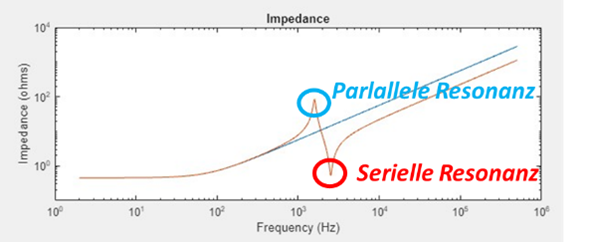
Impact of Electrical Equipment on Frequency-Dependent Grid Impedance up to 150 kHz
- Posted by Harald
- On 18. February 2025
- 0 Comments
- GIA, Grid Impedance Analyser, NEW DEVICE, Power Grid, Research, Supraharmonics
Direct current charging stations for electric vehicles or photovoltaic inverters or heat pumps use active power electronics to convert alternating current to direct current. High switching frequencies (IGBT) are used for the DC or AC conversion in order to achieve the lowest possible switching loss and therefore the highest possible efficiency. Switching frequencies of 10 to 100 kHz are used for AC to DC conversion and > 100 kHz for DC to DC conversion, resulting in supraharmonic emissions (SH) in the frequency range of 2-150 kHz [1]. To characterize SH emissions, it is important to distinguish between primary and secondary emissions. Primary emissions are emissions generated by the emitting device itself. Secondary emissions are generated elsewhere in the power system and propagate due to low impedance [2]. These supraharmonic currents can propagate differently in the electrical grid depending on the frequency. For example, emissions may flow back to the transformer station at certain frequencies and sink to neighboring equipment at other frequencies.

In order to investigate the propagation of these supraharmonics, it is necessary to measure the frequency-dependent grid impedance. The grid impedance in the harmonic frequency range (< 2 kHz) is mainly influenced by the components of the power grid [3] but is now also influenced by powerful DC e-charging stations [4]. The grid impedance in the frequency range from 10 kHz to 150 kHz is mainly influenced by powerful electronic equipment such as PV systems, e-charging stations, heat pumps or motors (VFD) and the grid impedance in the frequency range above 500 kHz is influenced by low-power electronic devices (power supplies, lighting, etc.). According to [3], the main factors influencing the frequency-dependent grid impedance are the capacitance of the DC link and the input-side grid EMC filter (e.g. LCL).
For this very reason, we have developed the world’s first mobile mains impedance measuring device, which has also been nominated for the Innovation Award of the Austrian Association for Electrical Engineering (OVE). The following illustration shows the GIA3 mains impedance measuring device for three-phase measurements up to 420 kHz with the PQA8000H supraharmonic PQ analyzer:

The following example shows the effects of an LCL input filter of an e-charging station on the frequency-dependent grid impedance at a connection point in the distribution grid. While the electrical distribution grid and its components exhibit an ohmic-inductive behavior, a parallel and serial resonance point is created when an e-charging station is connected.

In the case of parallel resonances, emissions at this frequency can result in very high voltages, which can cause interference in other devices. In the case of serial resonances, devices could be subjected to excessive thermal stress or digital communication (PLC, ripple control) could be severely disrupted. In addition to troubleshooting and fault finding, mains impedance meters are also used to evaluate the connection of electrical equipment (TAR, DACH-CZ Ed.3). With regard to DACH-CZ Ed.3, we now have our own tool for evaluating the frequency-dependent grid impedance and the harmonic and supraharmonic currents and assessing the grid connection. See this LINK.
The large number of electronic equipment with high power (>5 kW) that is currently and will be connected to the grid in the future will bring substantial changes to electrical grids and emphasize the importance of measuring frequency-dependent impedance.





0 Comments